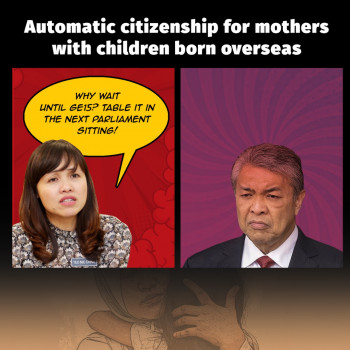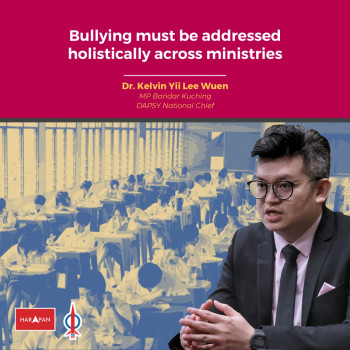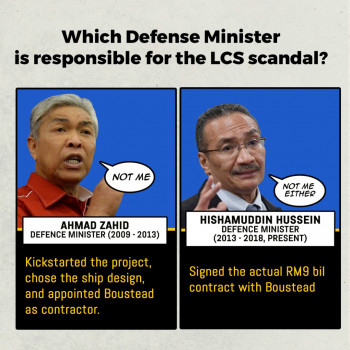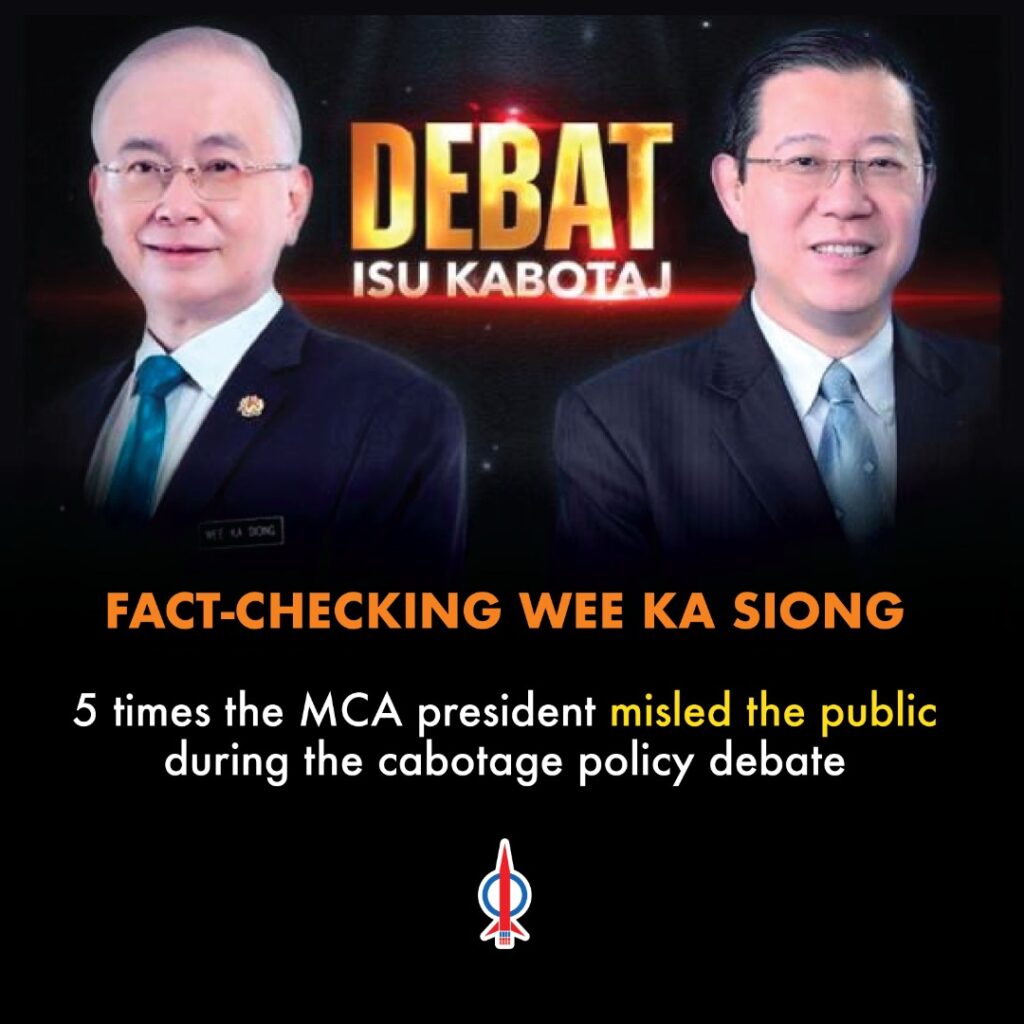
Fact Checking Wee Ka Siong on the Cabotage Policy Debate
Three days ago, the country witnessed a debate on the undersea submarine cable repair cabotage policy between the Minister of Transport and President of the Malaysian Chinese Association (MCA), Dr Wee Ka Siong, and the former Minister of Finance and Secretary General of the Democratic Action Party (DAP), Lim Guan Eng. It was a win for the Malaysian people as both sides presented their own facts and figures, using PowerPoint slides, via TV3, 8TV and Astro Awani, on live TV as well as various live streaming platforms.
In any debate on public policy, it is necessary to fact check the statements made by the debaters. I can vouch for the facts and figures presented by Lim Guan Eng since I was a member of the team that helped prepared his PowerPoint presentation. Sadly, I do not have the same confidence in some of the points made by Dr Wee in his presentation and they need to be highlighted for the public to know and for the press to ask more follow up questions.
1) Is NTT the ONLY shareholder and owner of the proposed Apricot undersea cable project?
Many times during the debate, Dr Wee wanted to create the impression that NTT is the ONLY owner of the proposed Apricot underseas submarine cable project that is bypassing Malaysia. This is grossly misleading as there are a number of other shareholders in the project including GOOGLE[1], Facebook[2], PLDT[3] which in the Philippines largest telco company and Chunghwa Telecom[4], a Taiwanese telco company.
“Google, Facebook, PLDT (telco in the Philippines), Chunghwa Telecom (telco in Taiwan), and NTT Ltd, today announced their participation in the Apricot subsea cable system. Specifically, these five companies have formed a consortium to construct this new international subsea cable system, named Apricot.”[5]
Did Dr Wee conveniently left out the participation of other players in the Apricot project because two of the shareholders, Facebook and Google, were part of a group of companies (Malaysians and well as international companies) which sent 2 letters to the former Prime Minister, Muhyiddin Yassin, and 1 letter to the current Prime Minister, Ismail Sabri, asking for Wee Ka Siong’s cabotage policy to be set aside and for the return of the former Transport Minister, Anthony Loke’s cabotage exemption policy on undersea submarine cable repairs?
2) Who is Mr Yoshio Sato?
Mr Sato appears TWICE in the debate on Tuesday via a recorded zoom call. Dr. Wee claims that Mr Sato was instrumental in the Apricot cable project and there is a slide in his presentation which shows Mr Sato as a Vice President of NTT.[6]
Mr Sato is no longer an employee of NTT because he left NTT to set up his own Singapore registered company called Orient Link Pte Ltd.
While I do not doubt that Mr Sato was working with NTT at the time that the Apricot undersea cable system was being planned, the Orient Link website states that he was only a manager at NTT and not a Vice President of NTT, as reported in the press.[7]
It was disingenuous for Dr. Wee to try to portray Mr Sato as someone senior in the NTT leadership while he was not. Even if he was a Vice President of NTT before leaving the company, it would not be accurate to portray this position as being part of the senior leadership of the company. For example, NTT currently lists down 13 Senior Vice Presidents as part of their executive or leadership team.[8] In other words, a Vice President in a Japanese company like NTT would be someone in the middle management or a senior manager level, as indicated in the Orient Link website.
In other words, Mr Sato is NOT with NTT and cannot speak on behalf of NTT’s future investments in the region and he was at best, a senior manager, in the company when he was working there.
3) What is Orient Link and what links does it have with companies in Malaysia?
As stated earlier, Mr Yoshiao Sato is the CEO of Orient Link Pte Ltd which is a Singapore registered company. In Orient Link’s website, it is described as “a strategic joint venture company led by NTT Group and established with partners of Fund Corporation for the Overseas Development of Japan’s ICT and Postal Services Inc. (JICT) and WEN Capital Pte. Ltd. (WEN)”. [9] In a press statement by the Japan ICT Fund or JICT dated December 13, 2019[10], it was stated that the Director of Wen Capital is none other than Mr Lim Soon Foo.
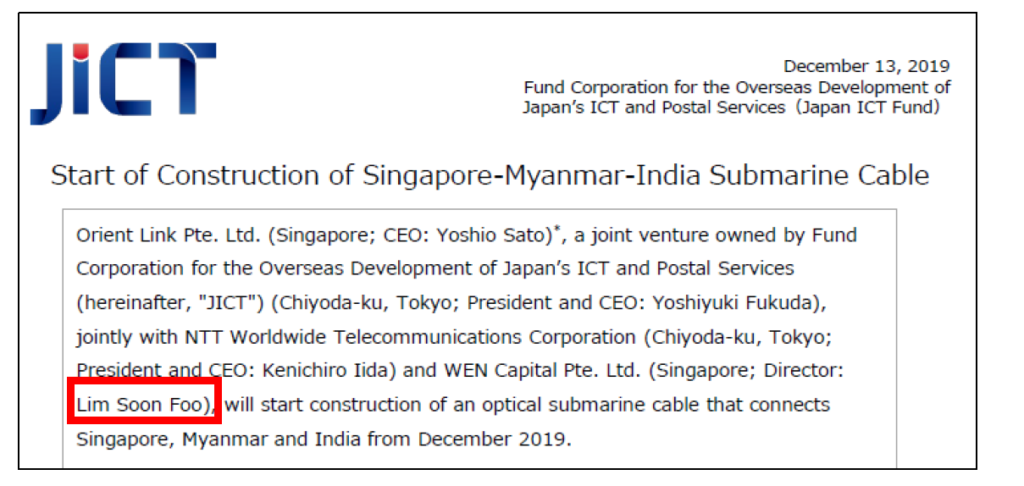
If the name Lim Soon Foo sounds familiar, it is because he is the executive chairman of OMS Group[11] which is, at the time of writing, the ONLY company in Malaysia which claims to have undersea cable submarine repair capabilities and seems to be, at the time of writing, the ONLY beneficiary of the cabotage policy which Dr Wee reinstated when he became transport Minister.
The fact that Lim Soon Foo is both a director of Wen Capital Pte Ltd, which is a part shareholder of Mr Sato’s company, Orient Link Pte Ltd, and is also the Executive Director of OMS Group, which is the main beneficiary of the undersea cable repair cabotage policy, shows that there is a clear conflict of interest on the part of Mr Sato. Could we expect Mr Sato to speak independently on his views on the cabotage policy if one of his company’s shareholders is also the main beneficiary of this policy? I think the answer to this question is obvious to all.
4) What is the Intra-Asia Express Cable Project and will it come to Malaysia including Sarawak?
One of the ‘trump cards” which Dr. Wee left for the end of the debate was the “Intra-Asia Express Cable Project” which Mr Sato is currently consulting on and would connect Japan, Taiwan, the Philippines, Brunei, Sarawak, Peninsular Malaysia and Singapore. Again, since Mr Sato is not working with NTT, this CANNOT be considered, at this moment, as an official NTT project. It is merely a proposed project out of many undersea cable projects in the region.[12] In addition, Mr Sato clearly says that “I need your big help for this project” to Dr Wee.[13] While our Ministers should be working hard to facilitate projects that bring benefits to Malaysia including subsea cable investments, the fact that Mr Sato seems to be ‘dependent’ on Dr Wee also calls into question the independence of his testimony in the two video clips shown during the debate. Is this another case of “I help you, you help me”?
5) Does the newly purchased Lodbrog ship by OMS Group have DP2 capabilities?
Finally, Dr. Wee also claims that OMS group had recently purchased a ship by the name of Lodbrog which has Dynamic Positioning 2 (DP2) undersea cable repairs capabilities. But the technical specifications from the OMS group website seems to tell a different story.
Technical Specifications from OMS’ website showing that Lodbrog is a DYNAPOS AM/AT ship[14]

The OMS website shows that Lodbrog is a DYNAPOS AM/AT type ship which when we refer to the classification schemes of Dynamic Position capabilities, clearly shows that Lodbrog only has DP1 or DP(AM) capabilities, and NOT the DP2 capabilities which Dr. Wee claimed during the debate.
Explanation of Dynamic Position Systems (DPS) 1, 2 and 3 Classification Schemes with DP(AM) clearly shown as a DP1 ship[15]
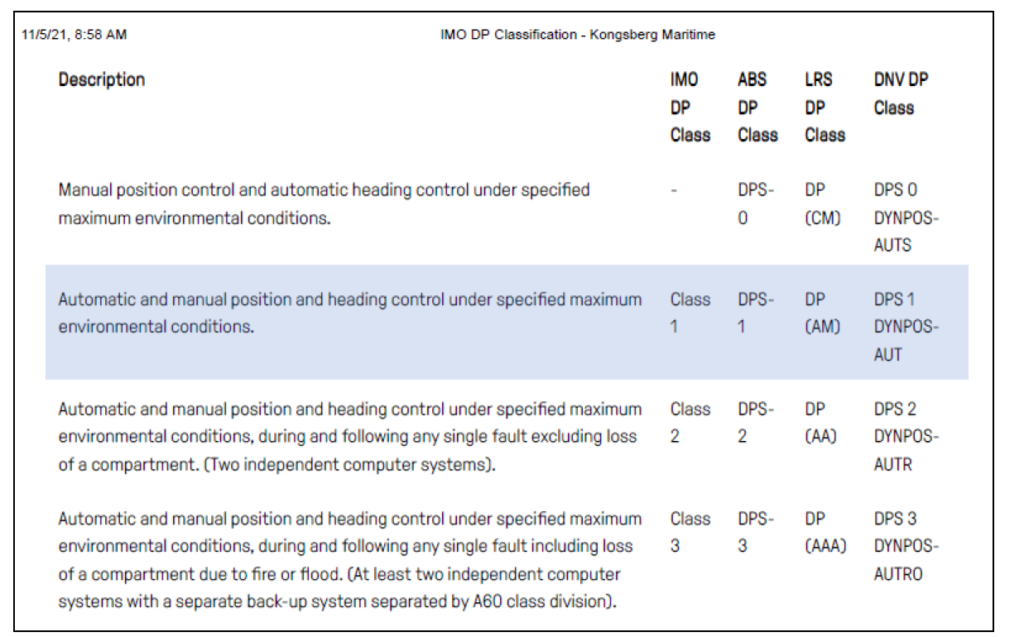
In contrast, ASEAN Explorer, a cable laying and repair ship which is owned by ASEAN Cableship Pte Ltd, of which Telekom Malaysia is a 16.7% shareholder, is clearly shown to have Dynamic Position Systems 2 capabilities or DP(AA), as listed on its own website.[16] (See below) The DP2 capabilities of Asean Cableship probably explains why MOT granted this ship SIX cabotage exemptions from November 2020 to March 2021 for undersea cable repairs in Malaysian waters.
If, for example, Lodbrog has the DP2 capability of undersea cable repairs as Dr Wee claims, why didn’t he show the number of times this ship conducted these repairs in Malaysian waters during the time that he was Minister of Transport, after he set aside the cabotage exemption policy? Surely, in a space of almost 12 months, there must have been opportunities for Lodbrog to conduct undersea repairs in Malaysian waters, given that it is a Malaysian registered vehicle based in Port Klang?[17]
Technical Specifications of Asean Explorer, which is owned by ASEAN Cableship, where Telekom Malaysia (TM) is a 16.7% shareholder, showing that it has DP2 capabilities

6) Conclusion
I have highlighted 5 very specific areas where Dr. Wee has misled the public during the debate with Lim Guan Eng on the undersea cable repair cabotage policy. I am sure that others with more specialized knowledge on the undersea cable laying and repair industry would be able to check to see if my fact checking here is correct. And they can also verify other statements that were made by both Dr. Wee and Mr Lim.
I also hope that this kind of debate can be replicated with other public policy makers both from the government and the opposition. With a rigorous press to fact check statements from all sides, I believe that we can head towards the path of a more mature democracy, debating based on facts and figures which can be checked and confirmed by independent parties.
Dr. Ong Kian Ming,
MP for Bangi

